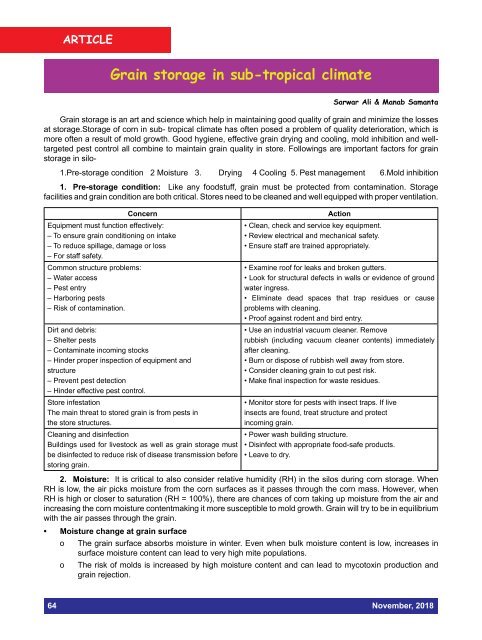November 2018 Punch PDF
You also want an ePaper? Increase the reach of your titles
YUMPU automatically turns print PDFs into web optimized ePapers that Google loves.
ARTICLE<br />
Grain storage in sub-tropical climate<br />
Sarwar Ali & Manab Samanta<br />
Grain storage is an art and science which help in maintaining good quality of grain and minimize the losses<br />
at storage.Storage of corn in sub- tropical climate has often posed a problem of quality deterioration, which is<br />
more often a result of mold growth. Good hygiene, effective grain drying and cooling, mold inhibition and welltargeted<br />
pest control all combine to maintain grain quality in store. Followings are important factors for grain<br />
storage in silo-<br />
1.Pre-storage condition 2 Moisture 3. Drying 4 Cooling 5. Pest management 6.Mold inhibition<br />
1. Pre-storage condition: Like any foodstuff, grain must be protected from contamination. Storage<br />
facilities and grain condition are both critical. Stores need to be cleaned and well equipped with proper ventilation.<br />
Concern<br />
Equipment must function effectively:<br />
– To ensure grain conditioning on intake<br />
– To reduce spillage, damage or loss<br />
– For staff safety.<br />
Common structure problems:<br />
– Water access<br />
– Pest entry<br />
– Harboring pests<br />
– Risk of contamination.<br />
Dirt and debris:<br />
– Shelter pests<br />
– Contaminate incoming stocks<br />
– Hinder proper inspection of equipment and<br />
structure<br />
– Prevent pest detection<br />
– Hinder effective pest control.<br />
Store infestation<br />
The main threat to stored grain is from pests in<br />
the store structures.<br />
Cleaning and disinfection<br />
Buildings used for livestock as well as grain storage must<br />
be disinfected to reduce risk of disease transmission before<br />
storing grain.<br />
Action<br />
• Clean, check and service key equipment.<br />
• Review electrical and mechanical safety.<br />
• Ensure staff are trained appropriately.<br />
• Examine roof for leaks and broken gutters.<br />
• Look for structural defects in walls or evidence of ground<br />
water ingress.<br />
• Eliminate dead spaces that trap residues or cause<br />
problems with cleaning.<br />
• Proof against rodent and bird entry.<br />
• Use an industrial vacuum cleaner. Remove<br />
rubbish (including vacuum cleaner contents) immediately<br />
after cleaning.<br />
• Burn or dispose of rubbish well away from store.<br />
• Consider cleaning grain to cut pest risk.<br />
• Make final inspection for waste residues.<br />
• Monitor store for pests with insect traps. If live<br />
insects are found, treat structure and protect<br />
incoming grain.<br />
• Power wash building structure.<br />
• Disinfect with appropriate food-safe products.<br />
• Leave to dry.<br />
2. Moisture: It is critical to also consider relative humidity (RH) in the silos during corn storage. When<br />
RH is low, the air picks moisture from the corn surfaces as it passes through the corn mass. However, when<br />
RH is high or closer to saturation (RH = 100%), there are chances of corn taking up moisture from the air and<br />
increasing the corn moisture contentmaking it more susceptible to mold growth. Grain will try to be in equilibrium<br />
with the air passes through the grain.<br />
• Moisture change at grain surface<br />
o The grain surface absorbs moisture in winter. Even when bulk moisture content is low, increases in<br />
surface moisture content can lead to very high mite populations.<br />
o The risk of molds is increased by high moisture content and can lead to mycotoxin production and<br />
grain rejection.<br />
64 <strong>November</strong>, <strong>2018</strong>





